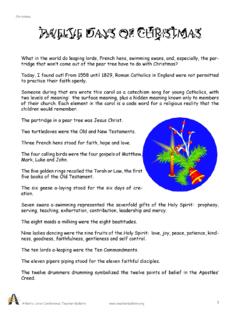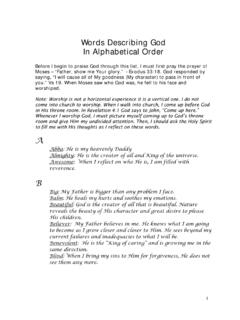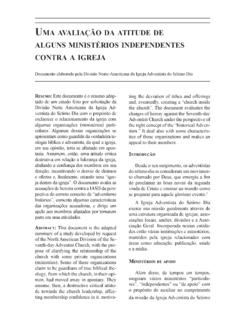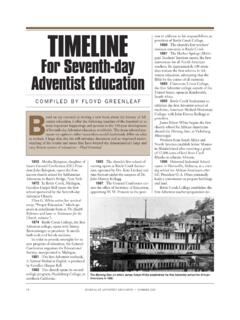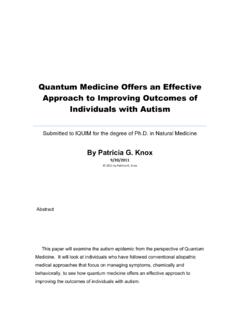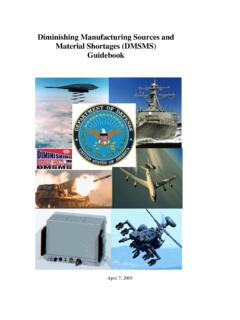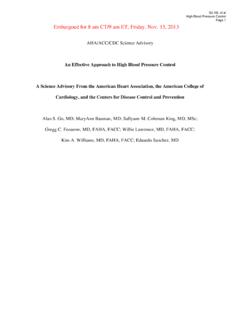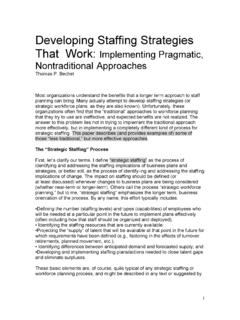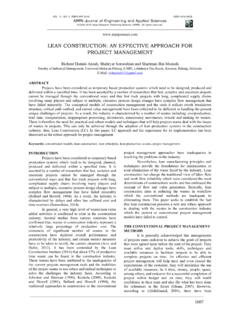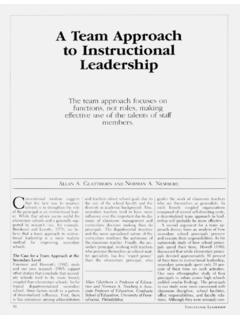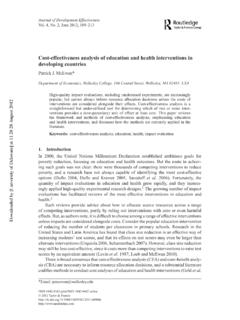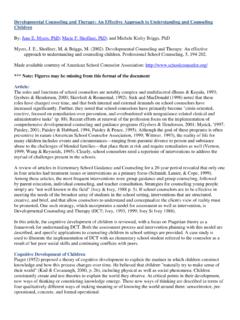Transcription of An effective Approach to Classroom Discipline and …
1 20 The Journal of Adventist Education February/March 2011 B Y E L V I N G A B R I E L a n dL I O N E L M A T T H E W SAn effective Approach to Classroom Discipline and Managementffective Classroom learning cannot occur unlessteachers are able to develop and implement effec -tive Discipline and management systems. The char-acteristics and nature of classrooms require thatteachers acquire and use higher-level managerial skills, which sig-nificantly enhance the quality of their instruction and leadership. Classrooms are multidimensional, in that they are crowded withpeople, tasks, and time pressures. Many people, all with differinggoals, preferences, and abilities, must share resources and accom-plish a variety of skills are not like simplerecipes or strategies that can be memorized and applied as needed.
2 Rather, they are a complex set of skills whose effective use dependsto a great extent on teachers personal philosophies and teachingstyles, on their knowledge and understanding of pedagogical prin-ciples, and on the composition of their THEORY21 The Journal of Adventist Education February/MarchThe ultimate objectives of Classroom Discipline and man-agement systems are: (1) to create and maintain environmentswhere learning is nurtured, valued, and efficiently imple-mented; and (2) to develop self- Discipline and self-control inlearners. To accomplish these objectives, teachers need to adoptrelevant instructional and management strategies that are de-rived from scientifically tested and verified theories.
3 ChoiceTheory, the focus of this article, has been implemented success-fully by teachers and administrators in elementary, middle, andhigh school Is Choice Theory?Choice Theory was developed by William Glasser, arenowned American psychologist and psychiatrist. He theo-rized that behavior is a choice made by an individual, based onhis or her feelings and needs, and is therefore not determinedor controlled by external other words, thepower lies within each person to determine how he or she willrespond to the demands of the social and physical environ-ment. Humans thus should not be perceived as victims or slavesof circumstances, but as self-determining beings who take re-sponsibility for the consequences of their Theory suggests that teachers cannot directly controlthe behaviors of students, since students choose how to reactto their feelings.
4 Teachers can help students identify the cir-cumstances that trigger their behaviors, which in turn empow-ers them to change their reactions to those feelings. As they doso, their behaviors will Concepts in Choice TheoryChoice Theory holds that five core concepts are founda-tional to Classroom management and Discipline : 1. Basic Needs, such as survival, love and belonging, power,freedom, and fun. World, which includes people, activities, values,and beliefs that are most important to each human being. 3. Reality and Perception, which suggest that people actbased upon what they perceive to be real. 4. Comparing Place, which builds on the notion that thepurpose of all behavior is to create a match between what peo-ple perceive and what they want; and 5.
5 Total Behavior, which has four components: acting,thinking, feeling, and physiology. Changing any of the fivecomponents will affect the others as This article empha-sizes ways in which teachers can implement two of these keyconcepts Basic Needs and theQuality World,to establishclassroom order and NeedsChoice Theory asserts that human beings have five basicneeds: (1) Survival, (2) Love and Belonging, (3) Power, (4)Freedom, and (5) Fun. These constitute the source of all inter-nal motivation and guide all human behavior. When teachersunderstand these needs, they can transform their classroomsinto places where students desire to learn, produce high-qualitywork, and behave need for survival(which includes food, shelter, andphysical comfort), is basic to human functioning.
6 However,there is also a psychological component to this need, which fo-cuses on order and Teachers can help students fulfilltheir survival needs by encouraging them to: (1) eat nutritiousmeals; (2) exercise regularly; (3) drink at least six glasses ofwater each day; (4) get plenty of fresh air; and (5) get adequateamounts of rest and sleep. Teachers also need to make sure thatthe lighting, seating arrangement, air circulation, and temper-ature of the Classroom are conducive to learning. Teachers maysatisfy students need for order and security by maintaining be-havior guidelines that support safety and respect; and develop-ing consistent Classroom procedures and routines that providestudents with a sense of order and need for love and belongingis perhaps the most im-portant need in Choice Theory, and it is critical to relationshipbuilding between students and teachers.
7 Students who are notloved and accepted by teachers and/or peers are likely to behavein ways that disrupt the learning process. Thus, teachers andadministrators must create caring learning communities wheretrust, respect, and tolerance are nurtured. Some of the waysthat teachers can do this are by: (1) greeting all students as theyenter the Classroom ; (2) allowing students the opportunity toknow them personally by sharing their outside interests, theirpersonal convictions, and information about their families andpersonal history; (3) regularly engaging students in team-building activities; and (4) teaching students how to work need for power is fulfilled through personal growth, de-veloping knowledge and skills that enhance the quality ofhuman life, encouraging higher achievement, and increasingstudents feelings of their need for power is notmet, students may act in destructive ways intimidating, con-trolling, and dominating teachers and peers through bullying,fighting, stealing, and destroying school property.
8 Teachers cansatisfy this need in students by: (1) giving them a voice in theclassroom, (2) soliciting their input regarding Classroom rulesand behavioral guidelines, (3) allowing them to generate ques-tions that guide the direction of the curriculum; (4) holding22 The Journal of Adventist Education February/March 2011 regular discussions about the rel-evance of the curriculum to stu-dents lives; and (5) teaching toaccommodate a variety of learn-ing wise choices is theessence of the need for must create opportunitiesfor students to make informedchoices about areas and issues thatpertain to their academic and social development, such as: (1) es-tablishing their seating arrange-ments; (2) selecting team membersfor cooperative learning activitiesor projects; and (3) participatingin the choice of assignments (top-ics for essays or class projects, out-side reading, and odd- or even-numbered math problems).
9 12 The need for fun encompassesa number of experiences including joy, pleasure, satisfaction,play, humor, merriment, amusement, and engaging in activitiesthat one is a by-product of having friends (love andbelonging), possessing autonomy (freedom), and feeling safeand secure (survival). Teachers may satisfy this need by (1) pro-viding opportunities for play, (2) inspiring creativity, (3) re-ducing stress; (4) helping children learn to cooperate and ne-gotiate with others; (5) engaging students in brain teasers andother types of academic games14; and (6) motivating studentsto participate in various leisure Quality WorldThe Quality World is a conglomeration of cognitive and vi-sual pictures and perceptions that represent what people havefound to be meaningful in their lives, which they use in decid-ing what they would like to experience repeatedly.
10 This QualityWorld is the core of their lives because in it are the people,things, and beliefs they have discovered that most satisfy If something is not part of one s Quality World, it maybe difficult to pursue it or experience it. One of the primaryreasons why students find it difficult to adjust to the expecta-tions of the school environment is that they lack a mentalimage of schoolwork in their Quality Students who continually disrupt the flow and momentumof Classroom instruction and activities may not want teachersor schoolwork in their Quality World because they do not findthese encounters and experiences to be meaningful or reward-ing. Teachers who do not understand the impact of students Quality Worlds on their growth and development may use lais-sez faireor coercive Discipline and management approaches,which can further alienate and marginalize those students.
